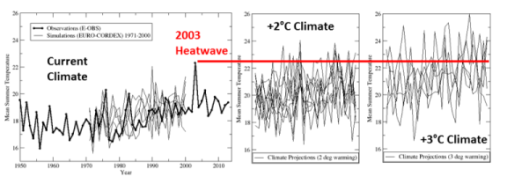Summer Heat Waves
Why is the content of this map important?
Heat waves are periods of temperature exceeding 5°C above normal lasting more than 5 days. On average, a few heat wave days per year are found in the 1971-2000 reference period. This number could rise to more than 10 days in general in a 3°C warmer climate. Limiting the warming to 2°C would halve this increase.
Which sectors are affected by this result?
Heat waves affect a number of economic sectors such as health, energy, agriculture, and ecosystems. They increase mortality and threaten harvests, and induce high river temperatures and low flows, which potentially lead to thermal electricity production management issues.
What is shown on the maps?
Figures show the current and future average number of heat wave days per summer. Heat waves are projected to become much more frequent in the future than throughout the 1971-2000 reference period. In most areas, the number of heat wave days are projected to increase by a factor of 2 to 10. A marked increase is simulated across Mediterranean areas.
Details and further information:
The heat wave that Europe underwent in 2003 is often taken as a reference point for future climate. The figure below shows mean summer temperatures in Central-northern France as observed (E-OBS), simulated and projected (EUROCORDEX) by an ensemble of models. Summers similar to the 2003 summer period were exceptional around 2000. Such summer conditions would be expected to remain infrequent under a +2°C global warming but become the norm under a +3°C global warming.
To investigate this, the ensemble mean of the five mandatory climate simulations is used. Hence, the ensemble consists of 5 simulations in total.
Heat waves are periods of temperature exceeding 5°C above the average summer mean (JJA) daily temperature lasting more than 5 days.
Author:
Robert Vautard
Centre national de la recherche scientifique (CNRS-IPSL), France
